Spinning and "Visual Stims"...
What's The Fascination With This Activity For The Autistic Child?...
If there is one thing that is characteristic of the autistic child it surely is his/her love of spinning things.
Zachary indeed loves to spin if given the opportunity. There are activities, other than spinning, that parents have also come to describe as "visual stims"... such as a child moving a pencil rapidly back and forth in front of his face. Spinning and such visual stims, I believe, are basically one and the same.
What is it about this activity that is so intriguing to the child with autism? The answer, once again, can be traced back to the issue of the "partial" verses the "whole". I'll use spinning in this example, but the same applies to other visual stims as well. This gets a little long, but read the whole thing... it is well worth the time and will give you a whole new outlook on spinning and so much more because, as the saying goes: "A Picture Is Worth A Thousand Words".
There are many parents and professionals who believe that spinning is simply a way to get a visual stimulation. If that were the case, spinning would not continue once eye contact with the spinning object was broken. That, however, is clearly not the case. Autistic children continue to spin while looking elsewhere... as shown in the pictures below. In the first set of pictures, Zachary is almost 5 years old and he is watching television. In the second picture, he is more fascinated by the fact that mom is taking yet another picture. In the third picture, Zachary is looking at something on the floor as he continues to spin. The second set of pictures was taken when Zachary was only 2 years old... yet the pattern was the same then too. The love of spinning was clearly present, as was the fascination with a specific part of the spinning object. Again, Zachary's attention is primarily with the inner part of the wheel when it is a wheel that is the object of the spinning activity. Again, eye contact is easily broken with the spinning object, as clearly shown in the second picture. If you look closely, you'll see Zachary had a small car next to him as he sat in the plastic bin. The small car was flipped over as he spun the wheels... looking about the room - happy as a lark!
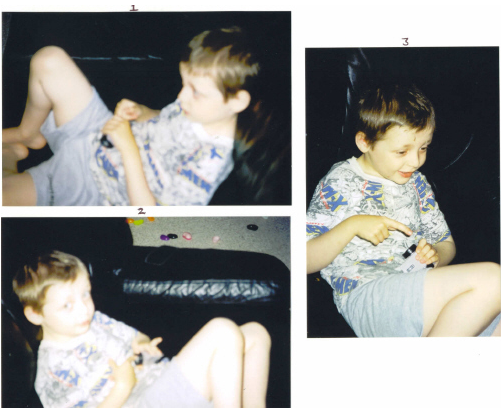
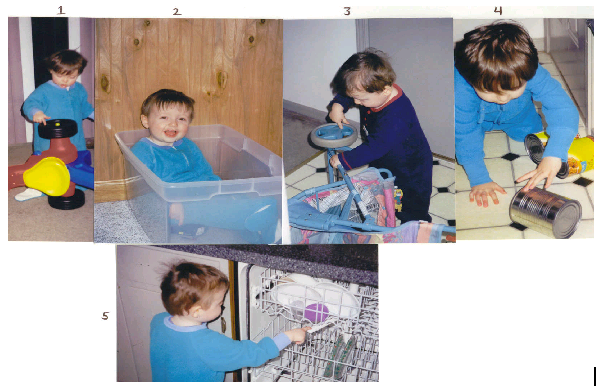
These pictures clearly indicate that there is more to spinning than simply the fact that it provides a "visual stim". So, if a visual stim isn't the answer to why autistic children spin... what is?
It is my firm belief that this activity is again, simply an "order fix" and stems from the autistic child's inability to process the "partial". Spinning is but an attempt at making the partial whole again.
Before going into greater detail on what I believe is going on when an autistic child spins, it is important for me to provide for you a description of the object Zachary is holding at almost age 5. This object illustrates the point quite well... although the same is true of pretty well all objects Zachary spun. This particular object, however, is the object that truly helped me to understand and so clearly see what is going on with this issue of spinning. This object is pictured below:

This is a little "car thing" I purchased one day at McDonald's©. It was part of the McDonald's Happy Meal© that week... we were just there to play on the equipment since Zachary can't eat anything in the restaurant due to the fact that he is on a casein free and gluten free diet. I often took Zachary to McDonald's© to play... to see how he interacted with other children. When he saw other children with this toy, of course, he wanted one also. So, I purchased the toy by itself.
There are a few interesting characteristics about this toy that readers need to take notice of. In the first picture, you can clearly see the toy has 2 large wheels with treads, and a smaller "wheel looking thing" in the middle of the toy. That small "wheel looking thing" in the middle of the toy has a "raised surface on it" that looks like a railroad track but with only one rail positioned in the middle of the track. In addition, if you look closely at the larger wheels, you will see that they have elevated "bumps" in the middle... to represent wheel studs. There is a larger one in the center, and 5 smaller ones around the larger one... they are barely visible on this picture, but they are there.
This is where things get interesting... the focus of Zachary's attention is clearly with the wheel studs in the middle of the wheels - parts to a wheel - parts to a whole. It almost looks as though he is trying to "pick them out" of the wheel... to get rid of them. In the second picture, note also the positioning of the fingers, on the wheel studs and the wheel treads. Also note that Zachary's first preoccupation was not with the activity of spinning, but rather with the wheel treads and wheel studs... the parts to the whole.
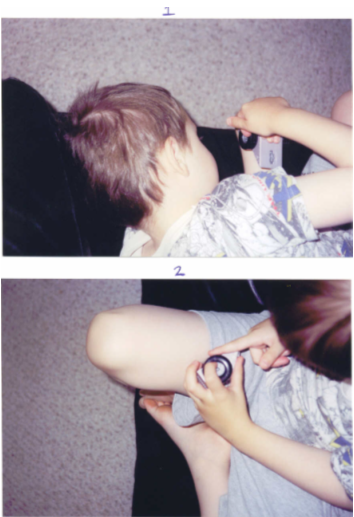
Zachary tried to "pick out" the wheel studs for quite some time... unable to do so, frustration set in and spinning started...
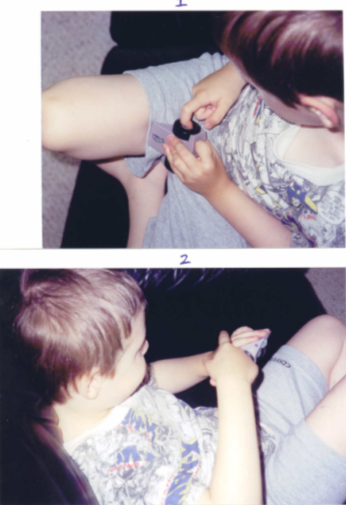
At this point, I asked Zachary to "stop spinning"... not willing to do that, he got off the couch - where he had been watching a movie - and resumed his spinning activity on the carpet. By then, I had noticed that Zachary only spun the big black wheels... he never tried to spin the little "wheel looking thing" in the middle of the car - so, of course, I asked him to spin the "small wheel" in the middle. His response surprised me... he stated: "no... no spinning small wheel". He then proceeded to do something else that was rather interesting...as depicted in the pictures below. I took the object and tried to spin the small middle wheel for him a few times in order to see his reaction. As I did this, Zachary kept saying: "no... no spinning small wheel". Once I gave him back his toy, he immediately physically positioned his thumb onto the "small middle wheel" to totally prevent it from spinning... and resumed the spinning of the large dark wheel.
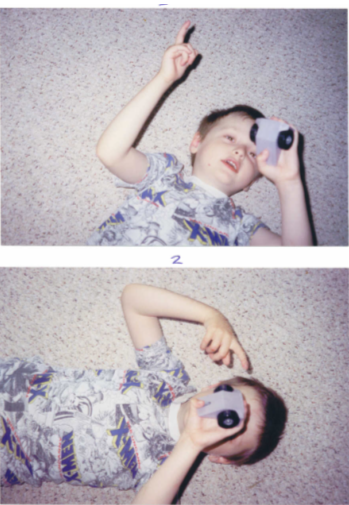
This was quite interesting to me. I took the toy car from him, and inspected the "small middle wheel" a little further. I again tried to spin this "middle wheel" myself. This time, however, I noticed it could not physically be spun fast enough to make the "raised surface that look like a one rail track" disappear. As I tried to spin this "little middle wheel", Zachary, in a very assertive voice shouted: "Stop spinning". He became frustrated by my attempt to spin the small wheel. I then gave Zachary the car toy again to see what he would do if further prompted to spin that "small middle wheel"...

Zachary simply took the car and started to push it along the floor. Well... there was a time where I would have been thrilled to see him do this... thinking he was actually using a toy appropriately... pushing a car. To society, this was "normal"... socially acceptable behavior. Zachary simply figured out that I allowed pushing cars... even when I said "no spinning"... because "pushing cars" was considered socially acceptable. This time, however, it took very little time for me to realize that even this "pushing of the car" was not "normal play" at all because Zachary's eyes were still very much focused on those wheel studs as he pushed the car along the floor. Again, he could easily break eye contact with the toy if I did something to result in his breaking eye contact with the object of interest. By this time, I was convinced that spinning was not a behavior the autistic child engaged in primarily for a "visual stim"... it was something else.
Zachary then figured out that he could take his toy car and have the wheels spin as he turned his Sit'N Spin©. So, I let him do that for a while, to the point, where eventually, the Sit'N Spin was going full speed as was the black wheel on which Zachary was so focused.
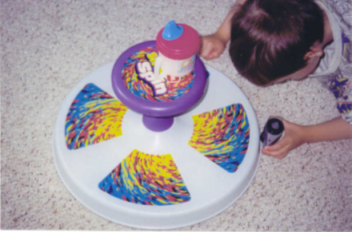
After this particular activity, Zachary was exhausted and went back to the couch to watch the rest of his movie. He placed the toy car next to him as he lay on the couch... and again, those wheel studs were positioned in his direct line of sight, as shown below. Although he was exhausted, Zachary was still somewhat restless, and for a short while, moved from one end of the couch to the other... moving the toy car and positioning the wheel studs each time he moved, again, in his direct line of sight.
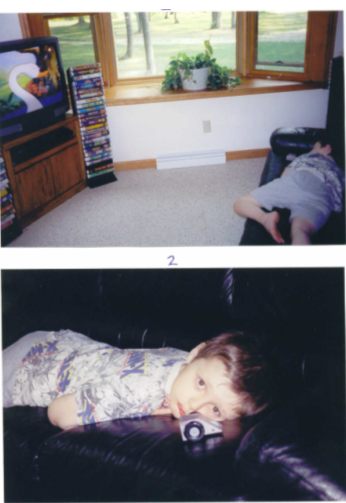
I soon realized that the inability to process partiality was at the root of the autistic child's fascination with spinning. Spinning, if you think about it, does something that few other activities can do... it can create a visual impression that allows the parts to become "the whole". As the toy car was spun, the wheel studs disappeared and became part of the whole. Since the "small middle wheel with the raised surface" did not spin fast enough to produce this illusion of the part becoming the whole, Zachary refused to spin it and in fact, did all he could to prevent even me from trying to do so. That particular "small middle wheel" was still very much a source of frustration for him.
This, in my opinion, is the key to the autistic child's love of spinning... spinning makes the parts become part of the whole... making the parts no longer easily distinguishable from the whole. It is important to note that "a part" can be as small as a "spec" on an object - it need only be "something" the child doesn't perceive as belonging there... as a "natural part" to the whole. The inability to understand the whole without first understanding the parts, is again, completely in line with what is observed in spinning. Until the child understands "the parts" - in anything in life - and how they "make up the whole", parts will continue to be a source of frustration for the autistic child and will continue to make him seek coping mechanisms, such as spinning, to help him deal with the frustration that results from those things, those "parts" in his world he can not make sense of.
This also explains why eye contact is not always necessary. "Just knowing" that the part is becoming a part of the whole as an object spins is surely comforting to the autistic child... putting his world "back in order"... providing that "order fix" he so desperately needs to cope. When Zachary couldn't physically find something to spin, he'd simply pretend to be spinning something with his finger "in the air" or on my cheek... that alone provided great comfort for him.
This issue of the partial and the whole also explains why the autistic child is so fascinated with ceiling fans. If the fan isn't moving, the child shows very little interest in it or begs to have it turned on. Most ceiling fans have 4 to 5 blades. As they begin to spin, the blades "disappear" and become part of a whole entity... no longer easily distinguishable from "the whole".
This also explains why even "odd" objects are spun by the autistic child... such as irregular puzzle pieces. It doesn't matter what shape the object is... once it starts spinning, the parts become part of the whole, resembling a circle even though the original shape was rather "odd". Even with "odd shapes", the illusion of a complete circle is formed by the spinning of the object. In addition, there is a blurring of any design on the puzzle piece so that it becomes fully integrated into the whole, again, eliminating any "parts" that can not be understood or properly processed by the child... and that's why, in my opinion, the autistic child loves to spin.
I can think of nothing else in the autistic child's environment that would provide this necessary coping mechanism the autistic child needs to cope with issues of partiality. Spinning, an activity so characteristic of the autistic child, is completely in line with my theory that the autistic child can not properly process the parts to a whole and that it is the inability to understand the "whole" without first understanding the "parts" that, in my opinion, results in tremendous frustration for these children. Spinning provides for the autistic child what no other activity can do... it makes the "parts" become indistinguishable from the "whole" and as such, spinning in the autistic child is, in my opinion, but a coping mechanism for the autistic child. Spinning is the perfect "order fix" for the autistic child... his perfect way to cope with partiality... to make the partial whole again! :o)